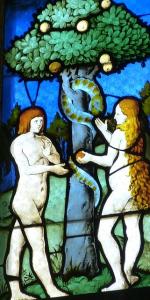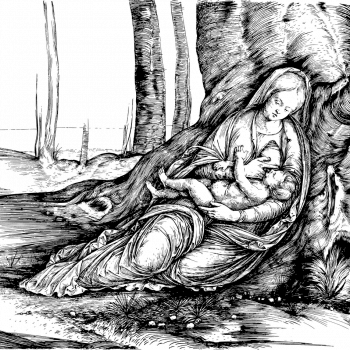Of all the Old Testament stories, the story of the Fall of Adam and Eve has had, in my opinion, the most profound and far reaching effects on humanity’s social and cultural history and on our group and individual psychological identity. We are told that Adam and Eve were created in Paradise, disobeyed God’s commandment, were driven from Paradise, and incurred that punishment/banishment not only for themselves but for all their descendants for all time to come. With that “sin,” we became a fallen people, destined to commit further sin because of our “fallen nature,” and who could only be redeemed by Divine intercession. This disobedience and its punishment has brought us feelings of guilt, unworthiness, and powerlessness which battle furiously with our sense of ourselves, as having been created in the image and likeness of God, each of us a tiny spark created to bring Divinity into the world. We experience “god” as wrathful, but we are told that he/she is a God of Love. In many ways, our mother Eve, because of the conventional interpretation of this story, bears the brunt of the responsibility for this “sin.” The cost to her and to respect for the Divine Feminine has been enormous. But stories are subject to different interpretations and I believe that to be the case here. The question I propose to explore in this essay is – when is a “sin,” not a sin?
The “sin” of The Fall re-interpreted
The Garden of Eden is God’s garden. He/she walks in the garden daily. All things in it are of his/her creation. God’s garden is not unlike a dream any of us might have on any given evening. We create the dream – the story line, the characters, the setting – and then we set it all in motion. With the Fall, God sets the Creation story in motion. There was nothing in the garden that hadn’t emanated from God. One element of God’s “dream” was that there be a Tree of the Knowledge of Good and Evil within the garden.
In Genesis 3, Eve encounters the serpent in the garden,
2 The woman said to the serpent, “We may eat fruit from the trees in the garden, 3 but God did say, ‘You must not eat fruit from the tree that is in the middle of the garden, and you must not touch it, or you will die.’”
The serpent is described as wily, cunning and sly, more so than any other animal in the garden. Why a serpent? The serpent is set apart from the others, because the serpent has a special capability, it can shed its skin. The snake is the tempter – the catalyst – because the snake possesses special knowledge regarding life and death. With the shedding of each skin, the snake is a symbol of transformation, of rebirth without death. The snake’s essence remains, the snake is in a sense immortal and hearkens to the immortality of the soul.
6 When the woman saw that the fruit of the tree was good for food and pleasing to the eye, and also desirable for gaining wisdom, she took some and ate it.
Eve was hungry – but not in a physical way. She desired wisdom. In the eating of the apple from the tree of good and evil, Eve becomes aware of duality, and with this realization begins her longing for unity, the energizing passion of the spiritual path.
She also gave some to her husband, who was with her, and he ate it. 7 Then the eyes of both of them were opened. . .
Eve accepts the apple and subsequently offers it to Adam. It is her gift of love; she offers Adam spiritual initiation. With the eating of the apple, Eve and Adam fully accept and embrace incarnation, with all its joys, sorrows, triumphs and tribulations.
10 He (Adam) answered, “I heard you (God) in the garden, and I was afraid because I was naked; so I hid.” Adam and Eve recognized themselves to be naked, because their eyes were opened. This was not only an awareness of their physical nakedness. The idea of one’s physical nakedness as something someone must hide gives rise to the idea of sexuality as something dark, evil, uncontrollable and irrational – what St. Augustine believes leads us to the “original sin” of each conception. Perhaps, they were reacting to their new vulnerability, to their new “separateness” from God.
As the story continues, Adam lays responsibility on Eve for his breaking of God’s commandment and Eve blames the serpent, claiming she was deceived. All are punished.
23 So the Lord God banished Adam and Eve. . . he (God) placed on the east side of the Garden of Eden cherubim and a flaming sword flashing back and forth to guard the way to the tree of life. (Genesis 3, New International Version)
Cherubim are placed on the east side of the garden, the side where the sun rises, a place of new beginnings, and where the spiritual path begins. According to Joseph Campbell in his book Myths to Live By, the two cherubim with flaming swords represent attachment and fear. These are the obstacles we must overcome in order to return to the garden, to the Tree of Life which remains in the garden, and to God. In the garden, Adam and Eve experienced God’s unconditional love and the wonder of Nature. It is a place to which they/we will want to return. Adam and Eve were protected, untested “children” – who needed to leave home in order to grow. Their expulsion propels them onto the spiritual path.
Was this a simple test of obedience designed by God, albeit with dire consequences? I don’t think so. This story has all the elements of the spiritual journey – a willingness to step away from the conventional, an awakening, a glimpse of immortality, a journey away from the familiar, a path that is uncharted. I think what God presented in the garden was an opportunity. The only question was – would Adam and Eve take it?
What did Eve unleash by eating from the Tree of Good and Evil?
With the eating of the apple, human experience of “duality,” the experience of opposites, begins in the world. That “duality” exists is evident by the existence of the tree in the garden. Within a single tree is both good and evil, both in one. Experiencing duality/separation and understanding/overcoming duality is the key to enlightenment and the understanding of ultimate reality.
Man’s human nature requires an understanding of what is good and what is evil, in order to navigate safely through life. Some things are evaluated as safe, some harmful and some neutral. As evidenced in the flight or flight response, humans are biologically programmed to divide their experiences in the world into good and evil, in order to survive.
But distinguishing good from evil is just the first stage of the journey. If we stop our exploration and learning there, and continue to apply the same simplistic rules, finding comfort in only what is compatible with ourselves, we descend further and further into limiting experiences, until we end up with a world view that tells us that any differences are suspect and anyone who doesn’t look like us is potentially dangerous.
Ignorance is not bliss! Ignorance feeds our fears. On the spiritual path, we will be forced to repeatedly face our ignorance, prejudice, and small mindedness, until we agree to look at all sides of the picture, to stand willingly in each other’s shoes and suspend judgment on what appears to be different from us.
If focusing on duality has at least the potential of luring us down such an unproductive path, what’s the point of “eating from the tree”? The answer is a question. Can we really know and appreciate the light without acknowledging and understanding the dark? Simply said, knowing both the dark and the light give us the fuller truth. Herman Melville, famous American novelist, tells us,
“There is no quality in this world that is not what it is merely by contrast. Nothing exists in itself.”
So, the eating of the apple is a necessary “temptation,” for without the experience of duality we can never know truth in its entirety. Jewish philosopher Martin Buber warns us against the ease and naturalness of getting “stuck” in duality,
It is usual to think of good and evil as two poles, two opposite directions, the antithesis of one another…. We must begin by doing away with this convention.
But, perhaps, it’s best to see this journey – from good to evil to good again – as more like a circle than a straight line, rather like a coin spinning on its edge.
British philosopher Alan Watts speaks even more deeply of the underlying “educational” twist of duality,
“Every explicit duality is an implicit unity.” – Alan Watts
How else can we possibly know the one – the implicit unity – without experiencing the other – the explicit duality? “The Fall” propels us headlong into explicit duality and away from our unified center. And, as the serpent says to Eve, with a true understanding of good and evil, when we truly digest that bite of the apple, we become “godlike.” Eve seeks this wisdom, she seeks unity.
When is a “sin,” not a sin? Sometimes a “sin” is a break with convention, which is actually a push toward human spiritual development. It is seen as a sin precisely because it flies in the face of accepted social order. The “fall” was necessary for we humans to embark on the road to spiritual evolution. The garden is a microcosm of all creation, all that we see and all that we are inside. Adam and Eve hadn’t yet been tested, and therefore could neither understand nor appreciate the wholeness, the unity of the garden. They/we will discover Truth through the juxtaposition of opposites and paradox. When we ultimately return to the garden, we will, of necessity, return changed.
Fallout from “The Fall”
In the conventional interpretation of this story, Eve is seen as weak, easily deceived, impetuous, and as the temptress, even though she didn’t force Adam to eat the apple. Therefore, one might construe, that women need guidance and protection, to protect themselves from themselves, so that they don’t fall into sin and drag others down with them. Women became the “purveyors” of temptation and sin, taking on the wily, cunning, and manipulative characteristics of the snake.
Tragically Eve has paid dearly for her role in this story. This has created a lack of respect for the Divine Feminine and its wisdom, creativity, compassion and strength. In every corner of the globe, there have always been and still are social, cultural, and psychological repercussions resulting from this conventional misinterpretation of this seemingly simple and straightforward story. Women have borne the brunt of its misinterpretation in every facet of their lives. Historically, we have seen it in the fight for women’s suffrage and equality, rights to own property and be educated, in the double standard in the workplace, in advertising, and the ever-present horror of sex slavery.
Why we need Eve/Divine Feminine in our lives
Eve (and through her all women) became somehow “less,” with this misinterpretation of the Genesis story. As a species, we are now experiencing, encountering, and evaluating fully half of the human population as somehow “less.” It is time that we acknowledge, honor and seek the guidance and leadership of women of all ages. We cannot succeed in solving the critical issues of our world, while engaging only one-half of the ingenuity and creativity of the world’s population. It is time to set the misconceptions of this story aside and to let our fear arising from our insecurities fall away.
Eve is the symbol of all women. Eve speaks for women and the Divine Feminine – she speaks for courage, for love, for compassion, for tenderness, for sharing, for imagination, for creativity, for transformation.
Who is Eve? What does she represent? The leap, unconventional thinking, the curious, the right brain – imagination, curiosity, pushing boundaries. We all know Eves – male and female Eves. Who are the Eves that you know in your life? Who pushes you onto the road to spiritual enlightenment? Do you recognize it as a gift of love – what the world needs more than anything right now. Will we allow Eve to lead us back into the garden?

















